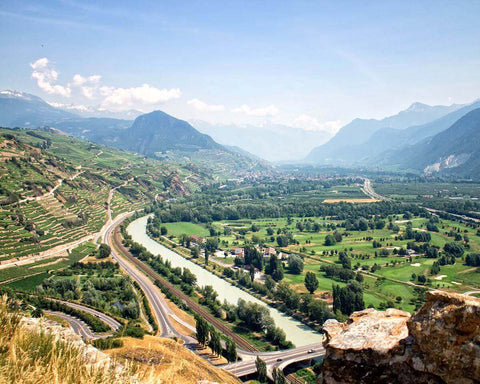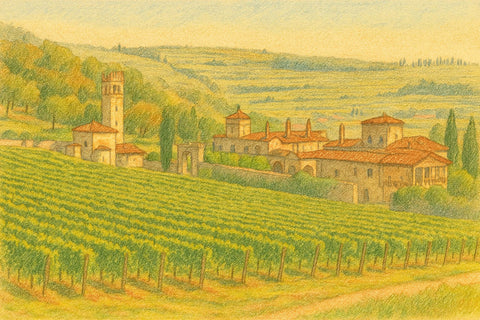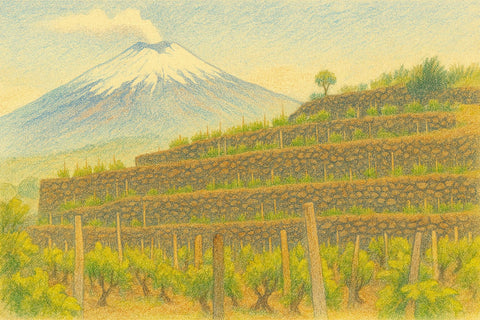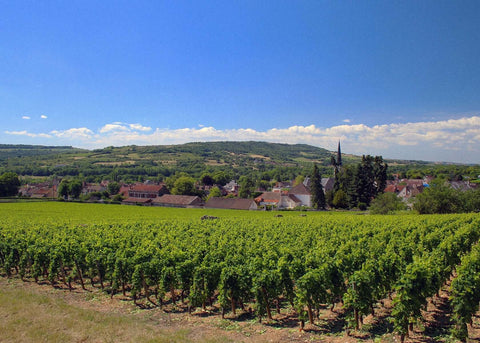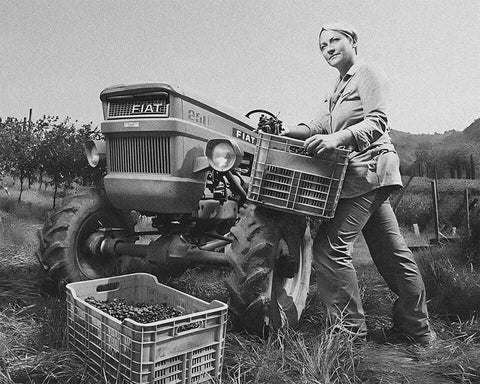Andalusia, Spain's southernmost autonomous community, stands as one of the world's most historic and distinctive wine regions. Bordered by the Atlantic Ocean to the west, the Mediterranean Sea to the south, and the rugged Sierra Morena mountains to the north, this vast region produces wines that range from the legendary fortified Sherries of Jerez to the sweet mountain wines of Málaga and the emerging still wines of contemporary producers. Andalusia's unique combination of maritime influences, diverse microclimates, and millennia-old winemaking traditions creates wines celebrated for their complexity, intensity, and ability to express the essence of southern Spain. Over three millennia, Andalusia has evolved into a region that defies conventional winemaking wisdom. The region's dynamic wine landscape honors its Phoenician roots while looking toward the future.
Table of Contents
History of Andalusia
Andalusia's wine history represents the oldest continuous winemaking tradition in Western Europe, beginning over 3,000 years ago when Phoenician traders established the ancient city of Gadir (modern Cádiz) and planted the first vineyards. This sun-drenched region at the crossroads of Europe and Africa has been shaped by successive civilizations—Phoenicians, Greeks, Romans, Moors, and Christians—each contributing unique elements that define Andalusian wine culture today.
The Phoenicians, arriving around 1100 BCE, recognized the potential of Andalusia's coastal areas and established vineyards around their trading posts. They introduced advanced winemaking techniques and began the tradition of fortifying wines for sea voyages, laying the foundation for what would eventually become Sherry. The Greeks followed, bringing new grape varieties and refining cultivation methods, while establishing important trading relationships throughout the Mediterranean.
Roman rule transformed Andalusian viticulture into an industrial enterprise. The wines of Baetica (Roman Andalusia) were prized throughout the Empire, with amphorae from Cádiz found as far away as Hadrian's Wall. The Romans developed sophisticated aging techniques and established the first regulations governing wine production, creating a quality-focused culture that persists today.
The Moorish period (711-1492 CE) presented unique challenges and opportunities. While Islamic law prohibited alcohol consumption, pragmatic rulers recognized wine's economic importance and permitted continued production for export and non-Muslim populations. Moorish agricultural innovations, including advanced irrigation systems and the alembic still for distillation, proved crucial for Andalusian winemaking's evolution.
The Reconquista and subsequent Age of Exploration catapulted Andalusian wines to global prominence. Sherry became the wine of choice for English nobility, while Spanish conquistadors carried Andalusian wines to the Americas. The establishment of the solera system in the 18th century revolutionized production, creating the consistent, complex wines that made Jerez synonymous with quality fortified wine worldwide. Today, Andalusia continues this legacy while exploring new frontiers in still wine production and sustainable viticulture.
Terroir of Andalusia
Andalusia's terroir encompasses extraordinary diversity, from Atlantic-influenced coastal vineyards to continental mountain slopes, creating distinct environments that produce wines of remarkable variety and character. The region's geography, ranging from sea level to over 1,400 meters in the Alpujarra mountains, combined with its position between two seas and two continents, creates unique conditions found nowhere else in the wine world.
The region's climate varies dramatically between zones but shares common characteristics of abundant sunshine, limited rainfall, and significant temperature variations. The poniente and levante winds—cool Atlantic and warm Mediterranean breezes—play crucial roles in vineyard health and grape development, while the intense summer heat, moderated by altitude or maritime influence, creates the concentration and power characteristic of Andalusian wines.
The Geology of Andalusia
Andalusia's geological diversity reflects its complex tectonic history, providing soils that range from the famous albariza of Jerez to the decomposed schists of the Alpujarra, each contributing unique characteristics to the wines.
- Albariza: The white, chalky soil of Jerez, composed of limestone, clay, and silica, retains moisture during dry summers and reflects sunlight, creating ideal conditions for Palomino cultivation.
- Barros: Dark, clay-rich soils found in lower-lying areas, more fertile but producing wines of less finesse than albariza.
- Arenas: Sandy soils near the coast, providing good drainage and contributing to lighter, more delicate wine styles.
- Pizarra (Slate): Decomposed slate soils in mountain areas like Ronda and the Alpujarra, producing mineral-driven wines with great complexity.
This geological variety allows Andalusia to produce everything from delicate manzanillas influenced by ocean breezes to powerful mountain wines that capture the essence of their high-altitude terroir.
Climate and its Influence
Andalusia's climate represents a unique convergence of Mediterranean and Atlantic influences, creating conditions that range from the humid coastal areas of Sanlúcar to the extreme continental climate of interior mountains. This climatic diversity, combined with innovative viticultural techniques developed over millennia, enables the production of wines impossible to replicate elsewhere.
The Grapes of Andalusia
Andalusia's grape varieties reflect both ancient traditions and modern experimentation, with indigenous varieties perfectly adapted to extreme conditions alongside international varieties finding new expressions in this unique terroir.
White Grape Varietals
- Palomino Fino: The foundation of Sherry production, thriving in albariza soils and capable of producing everything from bone-dry finos to luscious sweet wines.
- Pedro Ximénez: Concentrated through sun-drying, creating intensely sweet wines of unparalleled richness and complexity.
- Moscatel de Alejandría: Ancient variety producing aromatic sweet wines, particularly renowned in Málaga and Sierras de Málaga.
- Vijiriega: Rare indigenous variety being rescued from near extinction, showing promising results in high-altitude vineyards.
Red Grape Varietals
- Tintilla de Rota: Ancient Andalusian variety producing deeply colored, powerful wines, particularly important in coastal Cádiz.
- Romé: Traditional variety of the Alpujarra, adapted to extreme altitude and producing distinctive mountain wines.
- Tempranillo: Increasingly important in areas like Ronda, expressing unique characteristics in Andalusia's warm climate.
- Syrah: Thriving in higher elevations, producing elegant wines that balance power with freshness.
Top Wines of Andalusia
Fino and Manzanilla: The pinnacle of biological aging, these bone-dry Sherries develop under a veil of flor yeast, creating wines of extraordinary complexity and delicacy. Fino from Jerez offers almond and herb notes, while Manzanilla from Sanlúcar adds a distinctive saline character from Atlantic breezes, representing one of the wine world's most unique expressions.
Amontillado and Palo Cortado: These exceptional Sherries begin life as finos before transitioning to oxidative aging, creating wines that combine the elegance of biological aging with the richness of oxidation. Amontillados offer hazelnut and toffee complexity, while the rare Palo Cortado represents Sherry's most mysterious and prized style.
Oloroso and Cream Sherries: Aged entirely through oxidative processes, Olorosos develop profound depth and concentration, with notes of walnuts, leather, and dried fruits. When sweetened with Pedro Ximénez, they become Cream Sherries, offering accessible sweetness balanced by complex aged character.
Pedro Ximénez and Moscatel: Andalusia's legendary sweet wines, made from sun-dried grapes, achieve concentration levels unmatched globally. Pedro Ximénez from Montilla-Moriles can reach extraordinary sweetness levels while maintaining balance, offering flavors of molasses, figs, and chocolate.
Modern Still Wines: A new generation of winemakers in areas like Ronda, Granada's Alpujarra, and coastal Cádiz produces exceptional still wines that showcase Andalusia's potential beyond fortified styles. These wines, from crisp albillos to powerful syrahs, represent Andalusia's exciting future while respecting its storied past.
Cuisine and Typical Products of Andalusia
Andalusian cuisine represents one of Europe's most ancient and influential culinary traditions, where Moorish sophistication meets Mediterranean abundance to create a distinctive gastronomic identity. The cuisine emphasizes the transformation of simple ingredients through technique and time, from the perfect gazpacho to complex game stews, always designed to complement the region's distinctive wines. This culinary heritage, celebrated in everything from village festivals to Michelin-starred restaurants, reflects Andalusia's position as a cultural crossroads.
The foundation of Andalusian cooking rests on extraordinary olive oil, abundant seafood from two coasts, mountain hams, and sun-ripened vegetables. The Moorish legacy appears in the sophisticated use of spices, nuts, and the balance of sweet and savory, while the proximity to Africa adds exotic touches. The tradition of tapas, born in Andalusian taverns, has conquered the world while remaining most authentic in its birthplace.
Among Andalusia's contributions to world cuisine are dishes that define Spanish cooking internationally—gazpacho, paella's predecessor, fried fish, and countless tapas. The region's food culture emphasizes sharing, seasonality, and the inseparable relationship between food and wine, with Sherry playing a crucial role not just as beverage but as cooking ingredient.
Andalusian Antipasti
Andalusian meals often begin with tapas that showcase the region's diverse influences and exceptional ingredients:
- Jamón Ibérico de Bellota: Acorn-fed Iberian ham from Huelva's dehesas, the pinnacle of charcuterie.
- Tortillitas de Camarones: Crispy shrimp fritters from Cádiz, perfect with chilled manzanilla.
- Salmorejo: Thick tomato and bread purée from Córdoba, garnished with egg and jamón.
- Boquerones en Vinagre: Fresh anchovies marinated in vinegar, garlic, and parsley.
Andalusian First Courses
First courses celebrate Andalusia's agricultural bounty and Moorish influences:
- Gazpacho Andaluz: The classic cold tomato soup, perfect for hot summers and showcasing premium olive oil.
- Ajo Blanco: Ancient white gazpacho with almonds and grapes, predating tomato's arrival from the Americas.
- Porra Antequerana: Thick cold soup similar to salmorejo but with distinct regional variations.
- Migas: Fried breadcrumbs with chorizo, peppers, and garlic—shepherd's food elevated to art.
Andalusian Second Courses
Main courses range from simple fried fish to elaborate stews:
- Pescaíto Frito: Mixed fried fish, the soul of Andalusian coastal cooking, perfect with fino.
- Rabo de Toro: Oxtail stew from Córdoba, slow-cooked with vegetables and wine.
- Flamenquín: Pork loin wrapped around jamón, breaded and fried—indulgent and traditional.
- Atún Encebollado: Tuna with onions from Cádiz, showcasing the prized almadraba catch.
Andalusian Side Dishes
Side dishes highlight vegetables and Moorish influences:
- Espinacas con Garbanzos: Spinach with chickpeas, seasoned with cumin—classic Moorish-influenced dish.
- Berenjenas con Miel: Fried eggplant with honey, balancing sweet and savory.
- Pipirrana: Chopped vegetable salad dressed with olive oil and vinegar.
Andalusian Cheeses
Andalusia produces distinctive cheeses, particularly from goat's milk:
- Payoyo: Award-winning goat and sheep cheeses from Grazalema, aged in natural caves.
- Queso de Málaga: Fresh goat cheese, often served with honey or quince paste.
- Queso de Almería: Pressed goat cheese with herbs, traditionally made in esparto baskets.
- Torta de la Serena: Creamy sheep's milk cheese from northern Andalusia.
Andalusian Desserts
Desserts show strong Moorish and conventual influences:
- Tocino de Cielo: "Heaven's bacon," a rich egg custard with caramel, originally from Jerez convents.
- Pestiños: Honey-coated fried pastries with sesame, traditional at Christmas and Semana Santa.
- Alfajores: Spiced honey and almond cookies with Moorish origins, specialty of Medina Sidonia.
- Torrijas: Andalusian-style French toast soaked in wine or milk, fried and sweetened.
Typical Products of Andalusia
Andalusia's culinary wealth rests on exceptional products, many with protected designations, that reflect the region's diverse geography and cultural heritage.
Aceite de Oliva Virgen Extra
Andalusia produces over 80% of Spain's olive oil, with protected designations in Baena, Priego de Córdoba, and Sierra de Segura. These oils, from varieties like Picual and Hojiblanca, range from intensely fruity to delicately sweet, forming the foundation of Andalusian cuisine.
Jamón de Huelva DOP
The dehesas of Huelva produce Spain's finest Iberian hams, where black pigs feast on acorns creating jamón ibérico de bellota—marbled meat with incomparable nutty sweetness that pairs perfectly with Sherry.
Mojama
Salt-cured tuna loin from Cádiz and Huelva, this "ham of the sea" represents ancient preservation techniques. Sliced thin and drizzled with olive oil, it exemplifies Andalusia's mastery of transforming simple ingredients.
Vinagre de Jerez
Sherry vinegar, aged in the same solera system as the wines, achieves extraordinary complexity and forms an essential component of Andalusian cooking, from gazpacho to escabeches.
More on Andalusia's History
Phoenician Foundations
The Phoenicians established Europe's oldest wine trade in Andalusia, creating fortified wines for long sea voyages and establishing viticultural practices that would endure for three millennia, making the region the birthplace of European commercial winemaking.
Roman Golden Age
Under Roman rule, Andalusian wines achieved their first international fame, with systematic production, quality regulations, and extensive trade networks that made wines from Baetica prestigious throughout the Empire.
Moorish Innovations
Despite religious restrictions, Moorish rulers preserved and advanced Andalusian viticulture, introducing distillation, improving irrigation, and maintaining wine production for economic purposes, creating a unique period of multicultural wine development.
Age of Exploration
Andalusia's ports launched conquistadors and their wines to the New World, while Sherry conquered European courts, establishing trade relationships and the solera system that would define the region's wines for centuries.
Modern Renaissance
Today's Andalusia balances ancient traditions with innovation, as historic Sherry houses modernize while new producers in emerging regions demonstrate that Andalusia's wine future extends far beyond its illustrious fortified wine heritage.


